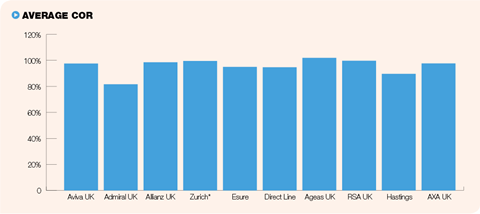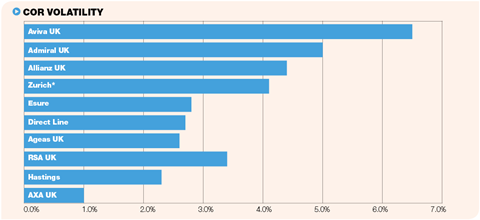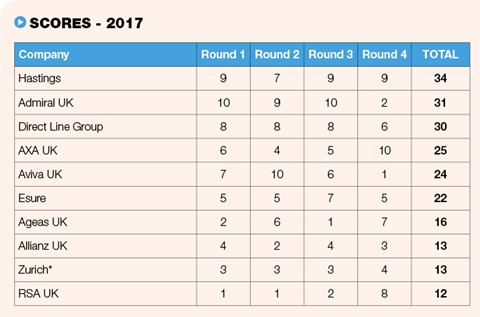Can Hastings retain the top spot? Or will Admiral’s resurgence knock it off?
Hastings has fought off a resurgent Admiral to retain the top spot in Insurance Times’ annual ranking of the financial performance of the leading insurers in UK GI.

The insurer clung on to the gold medal despite Admiral reporting record profits in 2017 after a difficult 12 months a year earlier following the government’s shock decision to cut the personal injury discount rate to minus 0.75% from 2.5%.
Hastings’ lead was cut to just four points this year, however, after establishing a seven point lead at the top in its debut in the rankings 12 months ago.
While Hastings did not top the table in any of our four ranking criteria, the insurer did secure second spot for all but one measure, coming in fourth for its year-on-year improvement in its combined operating ratio (COR) after a steady year of underwriting improvements.

The insurer reported a profitable COR of 87.0% for 2017, an improvement of 4.3 percentage points on 2016, aided by an impressive calendar year loss ratio of 73%, which was better than the insurer’s target range of between 75% and 79% and a 4.7 percentage point improvement on the previous year.
Admiral meanwhile topped the rankings for both the best 2017 COR and the best five year average COR, as well as securing second place for its improved combined ratio compared to 2016 with reserve releases continuing to bolster the insurer’s underwriting profitability.
Where Admiral fell short, however, was on the volatility of its underwriting performance, reporting the second highest COR volatility of the ten insurers in this analysis over the last five years.
This was largely a result of the £150m hit it took following the slashing of the personal injury discount rate in 2016, when the insurer’s COR climbed 9.4 percentage points to 88.4% before dropping back down to 79.7%, just 0.7 percentage points higher than the 79.0% reported for 2015.
Ogden Impact Still Being Felt
Last year, the discount rate change was the big story of our annual rankings, and the impact of Ogden continues to be felt in this year’s analysis.
RSA had not reported on the impact of the discount rate change last year as its results came out before the announcement of the change, but its 2017 COR has suffered now the impact has worked its way through its books of business.

The resulting hit from the change was not as high as many expected, however, with the insurer reducing profits by £23m to account for the change, with £20m of that relating to the UK and £3m to Northern Ireland.
But the hit was still one of the contributing factors that led to RSA reporting a 104.3% COR for 2017, meaning that the insurer fell to the bottom of the rankings for both its 2017 COR and the reported improvement compared to its 2016 ratio.

This, combined with a poor showing for the five year average COR, meant that RSA fell to the bottom of our overall rankings, replacing Aviva at the foot of the table.

Aviva, meanwhile, was one of the insurers to include the impact of the discount rate change in its 2016 results, taking a £475m hit for that year, but an improved 2017 COR helped the insurer lift itself off the bottom of the pack to climb up to fifth place in the overall rankings for 2017.
Aviva reported a COR of 93.9% in 2017, its best of the last five years and a 12.4 percentage point improvement on the 106.3% COR it reported in 2016, meaning that it was the best performing insurer in our analysis for COR improvements compared to 2016.

This improvement is largely the result of the fallout from the 2016 discount rate hit, however, with the insurer’s 2016 COR excluding the impact of the Ogden rate change coming in at 93.9%, the same as the insurer reported for 2017.

Brexit set to play its part
Insurers could be set to benefit from a reversal of the discount rate change in the coming months, with those suffering the most from the original slashing of the rate now in pole position to take advantage of proposed changes to increase the discount rate from its new low rate of minus 0.75% to between 0% and 1%.
But Allianz UK chief executive Jon Dye has said he “wouldn’t be betting my house” on the new Ogden rate legislation coming into force in 2018 because of Parliament’s preoccupation with the small matter of negotiating the country’s withdrawal from the European Union.
“We know that it will be a long process to get it (the rate change) through parliament and to get the legislation passed,” he said in a call with journalists following the announcement of Allianz’s third quarter results for 2017. “That is a tough thing for the government to achieve in a world that is dominated by Brexit and its attendant legislative changes.
“In the meantime we have still got a rate that is minus 0.75%. We have to remember that, because that is the actual discount rate that applies to the serious personal injury claims world right now, and it will do until the law gets changed.”
So while the ongoing impact of the Ogden saga remains unknown for now, the one thing we can say for certain is that it will still be having a major impact on our rankings when they come round again in 2019.
METHODOLOGY
Insurers were ranked on four aspects of their combined operating ratio (COR) performance: full-year 2017 COR; how much the COR had improved over 2016; the average five-year COR; and COR volatility over five years.
For each of the four criteria, insurers were assigned a score of one to 10 depending on their position in the ranking for that category, with 10 points for the company at the top of the table and one point for the company at the bottom.
The scores for the four criteria were added together to give the final ranking. All four criteria were given equal weighting.






































1 Readers' comment